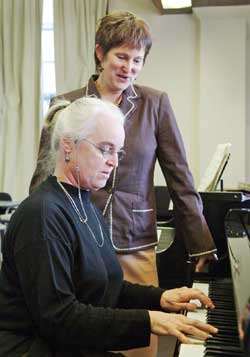Notes and neurons: BRAMS combines music and science
Multi-university project will open new workshop within the year

Virginia Penhune (Psychology) looks on as Christine Beckett (Music) plays a keyboard. Both professors are involved in the Brain Music and Sound (BRAMS) research centre that was launched last June with researchers from across Montreal and collaborators elsewhere in Canada, Europe and Australia.
Photo by kate hutchinson
When Plato studied at the school of Pythagoras, music and science were part of the same curriculum.
Professor Christine Beckett explained, “In the Middle Ages in university study, music was considered one of the sciences. It was one of the Quadrivium, which included arithmetic, geometry, astronomy and music.”
In the modern era, science and music are often separated by a substantial academic divide. Concordia professors Virginia Penhune (Psychology) and Beckett (Music) are part of a new interdisciplinary group putting the science back into music and the music back into science.
“They may be different realms, but there’s nothing to say that you can’t bring the one to bear upon the other,” Beckett said in a joint interview. “Now, with neuroimaging, rather than just being interested in the space around us, we can go within. How does our brain perceive sound, speech and music?”
Penhune said, “We have people like Evan Balaban, who studies low-level processing involving the cochlea and the brain. [He studies] sound in the most basic kind of way.
“There are people like Robert Zatorre and Isabelle Peretz, who are more interested in the neuropsychology of music and also of speech. And then you also have people like Christine Beckett, who are studying music pedagogy.”
Other research includes the study of music dyslexia, cochlear implants, and computerized analysis of musical style.
BRAMS, the Brain Music and Sound research centre, was launched in June 2005. The centre brings together researchers from Concordia, McGill and the University of Montreal. Its purpose is to study the neuroscience of music and auditory cognition.
“It was important that it be a multi-university consortium,” Penhune said. “It’s an extremely integrated group, and the centre has collaborators in France, Britain, Sweden, Australia and across Canada.”
Beckett added, “These people were here, there and everywhere, working in many different streams and BRAMS brings them together to be able to work with proper lab space and proper equipment.”
The centre has been doing renovations that will give researchers a common lab space at the University of Montreal.
“They’ve done an amazing renovation of one of these old convent spaces,” Penhune said. “The idea is that people will be able to come from other places, either visiting faculty members or students who want to work on collaborative projects, and have a lab that they can do work in. The idea is to attract and train really excellent students.”
Many of the researchers are also musicians, so the science is informed by a deep interest in and knowledge of music. For example, Dan Levitin comes from a rock background, and Beckett is a classical musician. Pascal Belin plays the banjo, Sylvie Hébert is studying jazz voice with Concordia Professor Jeri Brown, and Robert Zatorre is an organist.
Beckett said, “The interconnection between the artists and the researchers and scientists had been gradually moving closer together over at least two generations. Something like BRAMS could not have been possible 20 years ago.”
Researchers are planning a BRAMS workshop for a grand opening within the year.